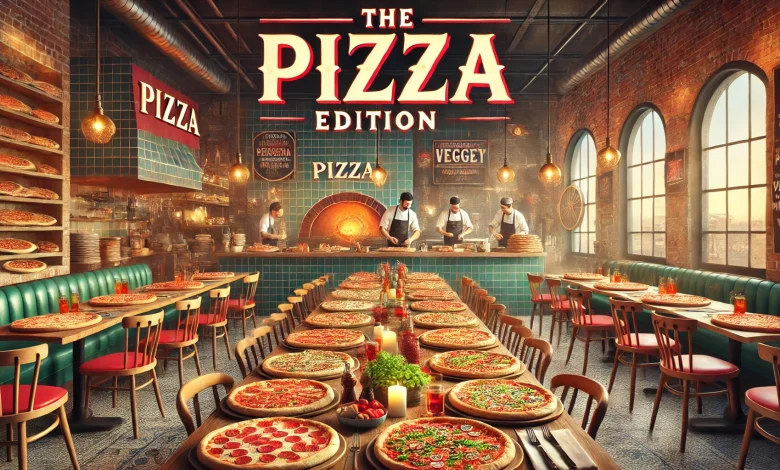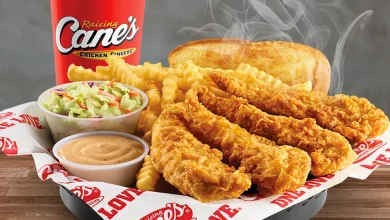The Pizza Edition: 4 Key Chapters of Pizza Perfection

Table of Contents
Pizza is more than just food; it’s a global phenomenon, a cultural icon, and a canvas for culinary creativity. In this first part of The Pizza Edition, we’ll explore the rich history, diverse styles, and the essential ingredients that make pizza one of the most beloved dishes in the world.
The History of Pizza: From Ancient Beginnings to Modern Classic
Pizza’s story begins long before it became the cheesy, tomato-sauced marvel we know today. Its roots trace back thousands of years, with ancient civilizations like the Greeks, Egyptians, and Romans preparing flatbreads with toppings. These early versions of pizza were simple yet delicious, serving as a foundation for what was to come.
1. Ancient Flatbreads: The Proto-Pizzas
- The Greeks and Egyptians baked flatbreads, often topping them with olive oil, herbs, and spices.
- The Romans had their version, called picea, which resembled modern focaccia.
2. Birthplace of Modern Pizza: Naples, Italy
- In the 18th century, Naples became the heart of pizza innovation. The introduction of tomatoes to Europe revolutionized the dish. Neapolitans began adding tomato sauce to their flatbreads, creating what we now recognize as pizza.
- By the late 19th century, the Margherita pizza was born. Queen Margherita of Savoy inspired this creation, featuring tomato sauce, mozzarella, and basil to reflect the colors of the Italian flag.
3. Pizza Goes Global
- Italian immigrants brought pizza to the United States in the late 19th and early 20th centuries.
- After World War II, returning soldiers popularized the dish further, and it quickly spread across continents, evolving into countless regional styles.
Exploring the Styles of Pizza: A World of Variety
Pizza isn’t one-size-fits-all; it’s a versatile dish that adapts to local tastes and traditions. Let’s dive into some of the most popular styles.
1. Neapolitan Pizza: The Original Masterpiece
- Characteristics: Thin, soft crust with a slight char from wood-fired ovens. Simple toppings include San Marzano tomatoes, fresh mozzarella, and basil.
- Notable Fact: Authentic Neapolitan pizza is protected by the Associazione Verace Pizza Napoletana (AVPN).
2. New York-Style Pizza: The Urban Classic
- Characteristics: Large, thin, and foldable slices with a crisp crust. It’s often sold by the slice in bustling city streets.
- Toppings: Traditionally topped with tomato sauce and mozzarella, but it’s a blank slate for creative additions.
3. Chicago Deep Dish: A Meal in Itself
- Characteristics: A thick, buttery crust that forms a deep “bowl” for toppings. Tomato sauce is placed on top of the cheese and other ingredients.
- Notable Fact: It’s more pie-like than traditional pizza, making it a hearty and indulgent option.
4. Detroit-Style Pizza: The Underdog
- Characteristics: Square-shaped with a thick, airy crust. Cheese is spread edge-to-edge, creating a caramelized, crispy border.
- Toppings: Often topped with pepperoni and finished with stripes of tomato sauce.
5. International Innovations
- Japan: Sushi pizza combines rice crusts with seafood toppings.
- Brazil: Sweet pizzas with toppings like banana and cinnamon are common.
- India: Spices like tandoori chicken and paneer add local flair.
The Building Blocks of Great Pizza: Essential Ingredients
The magic of pizza lies in its simplicity. Every element plays a vital role in creating a dish that’s both comforting and crave-worthy.
1. The Crust: The Foundation of Flavor
- Types of Dough: Traditional recipes use a simple mix of flour, water, yeast, and salt. Variations include sourdough bases or gluten-free options.
- Techniques: Kneading and proofing are critical for texture and flavor development.
2. The Sauce: The Flavor Backbone
- Classic Tomato Sauce: Made from ripe, peeled tomatoes, often San Marzano, seasoned with garlic, olive oil, and herbs.
- Creative Alternatives: Pesto, white sauces, or even barbecue sauce provide unique spins.
3. The Cheese: The Gooey Essential
- Mozzarella: Fresh or low-moisture mozzarella is a staple for its meltability and mild flavor.
- Other Cheeses: Parmesan, ricotta, and provolone add depth and richness.
4. Toppings: The Final Touch
- Traditional Favorites: Pepperoni, mushrooms, onions, and olives.
- Gourmet Choices: Prosciutto, truffle oil, arugula, and burrata.
- Seasonal and Local Ingredients: Seasonal vegetables or regional meats make pizzas unique.
The Science of Dough: Crafting the Perfect Crust
The crust is the heart of any pizza, and its quality depends on the dough. Making pizza dough may seem intimidating, but with the right approach, it becomes second nature.
1. Choosing the Right Flour
- All-Purpose Flour: A versatile option for beginners, yielding a softer crust.
- Bread Flour: Higher protein content results in a chewier, more elastic dough.
- 00 Flour: The gold standard for Neapolitan pizza, it creates a light, airy crust with a crisp edge.
2. Mastering the Dough Recipe
A basic pizza dough recipe includes flour, water, yeast, salt, and olive oil. The key is balancing hydration (water content) and kneading to develop gluten.
- Hydration Levels: Higher hydration (65-70%) makes a lighter crust but requires skill to handle.
- Kneading Technique: Stretch and fold to create elasticity without overworking the dough.
3. Fermentation and Proofing
- Cold Fermentation: Allowing the dough to rise slowly in the refrigerator enhances flavor and texture.
- Proofing Time: A long proof (12-48 hours) results in a more complex, airy crust.
Tools of the Trade: Essential Pizza-Making Equipment
Investing in the right tools can elevate your pizza-making game. Here are some must-haves for home pizzaiolos:
1. Pizza Stone or Steel
- A pizza stone mimics the intense heat of a brick oven, creating a crisp crust.
- A pizza steel conducts heat more efficiently, ensuring even cooking.
2. Pizza Peel
- A wooden or metal peel helps transfer the pizza into the oven. Dust it with flour or cornmeal to prevent sticking. The Pizza Edition
3. Dough Mixer or Hands
- While hand-kneading connects you to the process, a stand mixer with a dough hook saves time and effort.
4. Infrared Thermometer
- Ensures your oven or stone reaches the ideal temperature (450-500°F for most pizzas).
5. Other Essentials
- A rolling pin for thin crusts.
- A sharp pizza cutter or rocking blade for clean slices. The Pizza Edition
Sauce Secrets: Building the Base Layer
The sauce is where flavor begins. While classic tomato sauce reigns supreme, alternatives can add a unique twist.
1. Classic Tomato Sauce Recipe
- Ingredients: San Marzano tomatoes, garlic, olive oil, basil, salt, and sugar.
- Preparation: Blend the tomatoes lightly for texture, simmer with seasonings, and cool before spreading.
2. White Sauces
- Alfredo or Bechamel: Creamy bases pair well with mushrooms, chicken, or spinach.
3. Pesto and Beyond
- Basil or sun-dried tomato pesto adds a fresh, herby kick.
- Experiment with spicy harissa or hummus for unconventional flavors. The Pizza Edition
Mastering Cheese: The Art of Melting
Cheese is the soul of pizza, and its selection and application can make or break your creation.
1. Mozzarella Matters
- Fresh Mozzarella: Soft and creamy, it’s perfect for Neapolitan pizzas.
- Low-Moisture Mozzarella: Melts evenly without excess moisture, ideal for New York-style pizzas.
2. Cheese Blends
- Combine mozzarella with provolone, fontina, or gouda for complexity.
- A sprinkle of Parmesan or pecorino adds sharpness. The Pizza Edition
3. Vegan Cheese Options
- Cashew-based or soy-based cheeses are excellent substitutes for plant-based diets.
Topping Techniques: Layering for Perfection
The right toppings, applied thoughtfully, can transform your pizza into a masterpiece.
1. Balance is Key
- Avoid overloading your pizza; too many toppings can make it soggy.
- Distribute toppings evenly for consistent bites. The Pizza Edition
2. Pre-Cooking Ingredients
- Sauté vegetables like mushrooms and onions to reduce moisture.
- Precook proteins like sausage or bacon to ensure they’re fully cooked.
3. Creative Combinations
- Classic Pairings: Pepperoni and mushrooms, Margherita’s simplicity.
- Gourmet Twists: Prosciutto with arugula, figs with goat cheese, or pear with gorgonzola.
Baking Brilliance: Achieving the Perfect Cook
The final step in pizza-making is baking, where all your efforts come together.
1. Preheat for Success
- Heat your oven and pizza stone/steel for at least 30 minutes to ensure optimal temperature.
2. Bake Time and Temperature
- Neapolitan Pizza: 800°F in a wood-fired oven for 90 seconds.
- Home Ovens: 450-500°F for 10-12 minutes, depending on thickness.
3. Watch the Crust
- Rotate the pizza halfway through for even cooking.
- Look for a golden-brown crust with slight charring.
Regional Pizza Innovations: A World of Unique Flavors
Pizza’s adaptability has led to the creation of regional styles that reflect local ingredients and culinary traditions. These innovations showcase the versatility of pizza as a global phenomenon.
1. Italy: Beyond Neapolitan Pizza
While Neapolitan pizza is Italy’s most iconic style, other regions have their own interpretations:
- Roman Pizza: Known for its thin, crispy crust, Roman-style pizza (pizza alla pala) is often sold by weight and topped with a variety of fresh ingredients.
- Sicilian Pizza: A thick, square-shaped pizza with a fluffy crust, often topped with tomato sauce, anchovies, and breadcrumbs.
2. United States: A Melting Pot of Styles
The U.S. has embraced pizza with unparalleled enthusiasm, giving rise to numerous regional styles:
- California-Style Pizza: A lighter, more artisanal approach, featuring unconventional toppings like avocado, goat cheese, and arugula.
- St. Louis Pizza: Characterized by a cracker-thin crust and Provel cheese, this style is cut into squares rather than slices.
- New Haven Apizza: A coal-fired pie with a chewy crust, known for its “white clam” pizza featuring clams, garlic, and olive oil.
3. Japan: A Fusion of Tradition and Innovation
Japanese pizza often incorporates local ingredients and flavors, such as:
- Mayo Jaga Pizza: Topped with mayonnaise, potatoes, and corn, reflecting Japanese comfort food staples.
- Seafood Pizza: Featuring toppings like squid, shrimp, and seaweed for a distinctly Japanese twist.
4. India: Spices and Bold Flavors
Indian pizzas are a celebration of the country’s love for spices and vibrant flavors:
- Paneer Tikka Pizza: Combines marinated paneer (Indian cottage cheese) with tandoori spices.
- Chicken Tikka Pizza: Features grilled chicken chunks seasoned with Indian spices.
5. Brazil: Sweet and Savory Creations
Brazilian pizzas often blend sweet and savory elements:
- Romeo and Juliet Pizza: A dessert pizza with guava paste and creamy cheese.
- Calabresa Pizza: Topped with smoked sausage, onions, and oregano.
Pizza as a Cultural Icon: Its Role in Society
Pizza isn’t just food; it’s a cultural symbol that represents community, creativity, and comfort.
1. A Universal Comfort Food
Pizza’s universal appeal lies in its simplicity and adaptability. It’s a dish that brings people together, whether at a casual gathering, a family dinner, or a late-night snack.
2. Pop Culture Presence
From movies to TV shows, pizza has become a staple of pop culture. Iconic moments like the Teenage Mutant Ninja Turtles’ love for pizza or Joey Tribbiani’s devotion to slices in Friends have cemented its status as a beloved symbol of fun and indulgence.
3. Economic Impact
The pizza industry is a significant economic driver, supporting countless jobs and businesses worldwide. Chains like Domino’s, Pizza Hut, and Papa John’s have become global brands, while local pizzerias thrive on community support.
4. Pizza Festivals and Competitions
Pizza has inspired festivals and competitions, celebrating its artistry and innovation:
- World Pizza Championship: Held annually in Parma, Italy, showcasing the best pizzaiolos from around the globe.
- Pizza Expo: A trade show in Las Vegas, highlighting trends and innovations in the pizza industry.
The Future of Pizza: Trends and Innovations
As pizza continues to evolve, new trends and innovations are shaping its future.
1. Plant-Based and Vegan Pizzas
With the rise of plant-based diets, vegan pizzas are becoming more mainstream:
- Dairy-Free Cheeses: Made from nuts, soy, or coconut, offering creamy and melty alternatives.
- Creative Toppings: Roasted vegetables, plant-based meats, and nutritional yeast enhance flavor profiles.
2. Gluten-Free Options
For those with dietary restrictions, gluten-free crusts made from cauliflower, almond flour, or chickpea flour are gaining popularity.
3. Artisanal and Gourmet Pizzas
Artisanal pizzas focus on high-quality, locally sourced ingredients and innovative flavor combinations:
- Truffle Pizza: Featuring truffle oil, wild mushrooms, and creamy cheeses.
- Fig and Prosciutto Pizza: A sweet and savory masterpiece with fresh figs, prosciutto, and arugula.
4. Technology in Pizza-Making
- Pizza Robots: Automating the preparation and cooking process for efficiency and consistency.
- Smart Ovens: Allowing precise temperature control and even cooking.
- Delivery Innovations: Apps and AI-driven systems are revolutionizing how pizzas are ordered and delivered.
5. Sustainability Efforts
The pizza industry is embracing sustainability through eco-friendly packaging, locally sourced ingredients, and waste reduction initiatives.
Pizza in Festivals and Celebrations
Pizza has become a centerpiece of festivals and events, showcasing its ability to unite people and celebrate creativity.
1. Global Pizza Festivals
- Naples Pizza Festival (Italy): Held annually, this festival pays homage to the birthplace of pizza. Visitors enjoy live music, cultural performances, and, of course, authentic Neapolitan pizza.
- New York City Pizza Festival (USA): A celebration of New York’s iconic pizza culture, featuring tastings from renowned pizzerias and emerging chefs.
- Melbourne Pizza Festival (Australia): This event brings together traditional and modern pizza styles, highlighting the diversity of flavors in Australian pizza culture.
2. Pizza Parties and Gatherings
Pizza-themed parties have become a popular choice for casual celebrations, from birthday parties to corporate events. The interactive nature of making personal pizzas adds an engaging element to any gathering.
Unique Pizza Experiences
Pizza’s versatility extends beyond traditional dining, with creative concepts and experiences offering new ways to enjoy this beloved dish.
1. Pizza Theaters
Some restaurants provide an immersive dining experience where customers can watch their pizzas being prepared in open kitchens or wood-fired ovens. Theatrics like dough tossing and flame-kissed baking enhance the enjoyment.
2. Pizza Tours
Cities like Chicago, New York, and Naples offer guided pizza tours, allowing enthusiasts to explore the history, techniques, and flavors of regional pizza styles. the pizza edition
3. DIY Pizza Bars
Interactive dining experiences, where diners customize their pizzas with a selection of doughs, sauces, cheeses, and toppings, are becoming increasingly popular. the pizza edition
4. Pizza Trucks and Pop-Ups
Mobile pizza kitchens and pop-up events bring artisanal pizza to unexpected locations, from beaches to festivals, creating a sense of novelty and excitement.
Record-Breaking Pizza Feats
Pizza’s global popularity has inspired record-breaking attempts that push the boundaries of creativity and scale.
1. Largest Pizza
- The largest pizza ever made measured over 13,000 square feet and was created in Rome, Italy, using gluten-free ingredients to highlight inclusivity.
2. Longest Pizza
- A team in California crafted a pizza over 6,000 feet long, stretching the length of a boardwalk. It required hundreds of volunteers and specialized ovens.
3. Most Expensive Pizza
- A luxury pizza in Italy, called “Louis XIII,” costs over $12,000. It features exclusive ingredients like caviar, lobster, and rare cheeses, paired with fine champagne.
4. Fastest Pizza Maker
- Competitive pizza-making has become a niche sport, with chefs racing to stretch, sauce, and top pizzas in record time.
Pizza in Pop Culture and Media
Pizza’s influence extends beyond the kitchen, becoming a symbol of comfort and fun in movies, TV shows, and art.
1. Pizza in Movies and TV
- Iconic scenes, such as Kevin McCallister’s cheese pizza obsession in Home Alone or the pizza delivery in Spider-Man 2, have made pizza a cinematic staple.
- TV shows like The Office and Friends frequently use pizza as a backdrop for character interactions and humor.
2. Pizza in Art and Fashion
- Pizza has inspired artists and designers to create everything from pizza-themed paintings and sculptures to clothing and accessories.
- Social media platforms are filled with creative pizza photography, memes, and videos celebrating its cultural relevance.
3. Pizza Gaming and Virtual Experiences
- Pizza has even made its way into video games, with players managing pizzerias or competing in pizza-themed challenges. Virtual reality experiences allow users to simulate pizza-making in immersive settings.
Gourmet Pizza: Elevating the Everyday
1. Artisanal Ingredients
Gourmet pizzas focus on high-quality, locally sourced ingredients that redefine traditional flavors. In The Pizza Edition, gourmet offerings like truffle oil, wild mushrooms, burrata, and heirloom tomatoes have gained traction among food enthusiasts.
2. Unique Pairings
Chefs worldwide experiment with bold flavor combinations:
- Fig and Prosciutto: A sweet-savory masterpiece topped with arugula.
- Duck Confit and Blue Cheese: A luxurious twist on traditional toppings.
- Chili Honey and Ricotta: A spicy-sweet pairing that surprises the palate.
3. The Rise of Dessert Pizzas
Dessert pizzas have emerged as a creative trend, featuring toppings like Nutella, marshmallows, caramelized fruits, and mascarpone cheese. In The Pizza Edition, these sweet creations highlight pizza’s versatility.
The Role of Technology in Pizza Culture
Pizza and technology have merged to create innovative dining experiences, transforming how we enjoy this timeless dish.
1. Smart Pizza Ovens
Modern ovens equipped with AI technology ensure perfect cooking temperatures, crust textures, and baking times. These advancements are frequently showcased in The Pizza Edition.
2. Automated Pizza-Making Robots
Automation is revolutionizing pizza preparation, with robots capable of stretching dough, adding toppings, and baking pizzas with precision. These futuristic innovations are integral to the evolution of The Pizza Edition.
3. Delivery Drones and Robots
Pizza delivery has entered a new era with drones and autonomous robots ensuring faster and more efficient service. This futuristic touch adds excitement to The Pizza Edition.
4. Mobile Apps for Customization
Pizza apps now allow customers to design their pizzas virtually, choosing every detail, from crust thickness to topping placement. These apps are a testament to the digital age’s impact on The Pizza Edition.
Pizza and Sustainability
As environmental consciousness grows, the pizza industry has embraced sustainable practices to reduce its ecological footprint.
1. Eco-Friendly Packaging
Biodegradable and reusable pizza boxes are gaining popularity. These innovations align with the green initiatives promoted by The Pizza Edition.
2. Farm-to-Table Practices
Many pizzerias now source ingredients directly from local farms, ensuring freshness and supporting sustainable agriculture. This movement is a cornerstone of modern pizza culture, as highlighted in The Pizza Edition.
3. Reducing Food Waste
Efforts to repurpose leftover dough and toppings have led to creative menu additions, reducing waste while delighting customers. These practices resonate with the values of The Pizza Edition.
Pizza and Social Media: The Digital Influence
In the digital age, pizza has become a social media sensation, with countless posts, videos, and challenges celebrating its universal appeal.
1. Viral Pizza Challenges
Social media platforms are flooded with challenges like the “Biggest Slice Challenge” or the “Stuffed Crust Experiment,” driving engagement and showcasing the fun side of The Pizza Edition.
2. Pizza Photography
Capturing the perfect pizza shot has become an art form. Food bloggers and influencers highlight vibrant toppings, melted cheese, and charred crusts, bringing The Pizza Edition to life visually.
3. Pizza Memes and Humor
Pizza memes have taken the internet by storm, blending humor with a shared love for this iconic dish. These lighthearted creations are a key aspect of The Pizza Edition’s cultural impact.
4. Pizza NFTs and Virtual Collectibles
In the era of digital assets, pizza-themed NFTs and collectibles are emerging as unique ways to celebrate The Pizza Edition.
Conclusion: The Everlasting Appeal of Pizza
Pizza, as celebrated in The Pizza Edition, is more than just a dish—it’s a universal language of flavor, creativity, and culture. Its journey from the streets of Naples to becoming a global phenomenon showcases its unparalleled versatility. Whether it’s a classic Margherita, a gourmet truffle creation, or a dessert pizza, the adaptability of pizza ensures it remains a favorite for all generations.
In The Pizza Edition, we’ve explored its historical roots, regional innovations, technological advancements, and cultural significance. The pizza industry’s embrace of sustainability and digital trends further solidifies its place in modern dining. As new flavors, styles, and experiences continue to emerge, pizza will undoubtedly remain a cornerstone of culinary innovation and global connection.
FAQs: All About Pizza in The Pizza Edition
1. What makes pizza so popular worldwide?
Pizza’s universal appeal lies in its simplicity and adaptability. As highlighted in The Pizza Edition, its ability to cater to diverse tastes and dietary preferences ensures it resonates with people across cultures.
2. What are some unique pizza styles mentioned in The Pizza Edition?
From Neapolitan and Roman styles in Italy to New York, Chicago, and California pizzas in the U.S., The Pizza Edition also explores unique innovations like Japanese Mayo Jaga Pizza and Indian Paneer Tikka Pizza.
3. How has technology impacted pizza-making?
The Pizza Edition showcases advancements like smart ovens, automated pizza-making robots, and delivery drones, which have revolutionized the way pizza is prepared and enjoyed.
4. Are there sustainable practices in the pizza industry?
Yes, as discussed in The Pizza Edition, the industry is adopting eco-friendly packaging, farm-to-table sourcing, and waste reduction practices to minimize its environmental impact.
5. What are some emerging trends in pizza?
The Pizza Edition highlights trends like plant-based and vegan pizzas, gluten-free crusts, dessert pizzas, and artisanal creations featuring premium ingredients like truffle oil and burrata.
6. Why is pizza a cultural icon?
Pizza’s presence in pop culture, festivals, and even world records, as detailed in The Pizza Edition, underscores its role as a symbol of community, creativity, and comfort.
7. What is the significance of regional pizza festivals?
Pizza festivals, like the Naples Pizza Festival and New York City Pizza Festival, celebrate the artistry and cultural heritage of pizza, bringing people together to honor its legacy.
8. How has pizza influenced social media?
Pizza dominates social media with viral challenges, photography, memes, and even NFTs. As The Pizza Edition explains, these trends amplify its cultural relevance in the digital age.
9. What are some unusual pizza toppings featured in The Pizza Edition?
From fig and prosciutto to Nutella and marshmallows, The Pizza Edition highlights how chefs push boundaries with creative and unexpected flavor combinations.
10. What is the future of pizza?
The future of pizza, as envisioned in The Pizza Edition, includes continued innovation in ingredients, technology, and sustainability. Its ability to evolve ensures it will remain a beloved dish for generations to come.
11. What is the most expensive pizza in the world?
As highlighted in The Pizza Edition, the “Louis XIII” pizza from Italy holds the title for the most expensive pizza, costing over $12,000. It features luxurious ingredients like lobster, caviar, and rare cheeses, paired with fine champagne.
12. How has pizza influenced art and fashion?
Pizza’s cultural impact extends beyond food, as discussed in The Pizza Edition. It has inspired artwork, clothing, and accessories, making it a pop culture icon celebrated in creative industries.
13. What role do pizza festivals play in global culture?
Pizza festivals, such as those in Naples, New York, and Melbourne, serve as platforms to honor pizza’s heritage, showcase regional innovations, and bring communities together. The Pizza Edition emphasizes their importance in preserving pizza’s legacy.
14. What is the role of dessert pizzas in modern dining?
Dessert pizzas, featuring toppings like Nutella, fruits, and mascarpone, are a growing trend in modern dining. The Pizza Edition highlights their popularity as a sweet twist on this classic dish.
15. How is the pizza industry adapting to changing dietary preferences?
The pizza industry is evolving to meet diverse dietary needs, offering gluten-free crusts, vegan options, and plant-based toppings. The Pizza Edition explores how these innovations cater to health-conscious consumers without compromising flavor.


